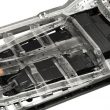Public-safety agencies should get ready for carrier-provided P25 managed services
1. First, be curious and know that you now have options:
As stated earlier, carrier-provided P25 services are not new and are used extensively in Canada and throughout the world. Therefore, this is a viable option for each of your public-safety agencies.
Many public-safety agencies are benefiting from carrier-provided P25 service through a carrier’s unique ability to leverage existing resources such as fiber backhaul, established cybersecurity operation centers, and extensive technical-support personnel. The carriers’ service model also provides a “richer” end-user experience by allowing agencies to mix and match radio subscribers and use cellular phones for non-mission critical communications while consolidating disparate P25 networks to increase interoperability.
Be curious; Be bold; Explore your options; Don’t accept conventional wisdom or stay in an undesirable relationship.
2. Know your strengths and limitations
Peter Drucker, the great business-school professor, once said that organizations can only build on strength. Applying his wisdom, I acknowledge that P25 as a service is neither a panacea nor recommended for all P25 radio projects. There will always be occasions where a hosted P25 service may not be the preferred solution, perhaps because the public-safety agency has sufficient capital funds and a large technical-support organization that has radio and IP expertise.
But our research shows that many government agencies have a shortage of human resources or lack the technical expertise to support today’s fault-tolerant P25 radio system on a 7×24 basis. Too often with privately purchased or government-owned radio systems, the public-safety agency is left on its own to monitor, maintain, and refresh the network.
Maintaining fault-tolerant networks is the carriers’ core business. They have NOCs; they have SOCs; they maintain 24-hour support operations; and they have an army of technical resources with the required expertise. We can all sleep better at night, knowing that the carriers will deploy a plethora of resources to support this life-saving technology.
3. Do it by the numbers
Many have claimed that acquiring P25 as a service can be more expensive when compared to owning and operating a P25 network. Those comparisons don’t include the true cost of ownership or the operational risks. For example, many studies do not include new staffing requirements for cybersecurity, facility costs for office and equipment, site leases, tower rental, site security, lighting, and maintenance, in additional to the capital cost of the investment.
As cited by the city of Ottawa, the overall cost of the P25 services during its 10-year term is comparable with a purchased system.
In closing, I would like to leave you with the following “food for thought”:
In the late 1890s, businesses and governments had generators in their basements. These smoke-belching, fuel-consuming power generators were manually operated and stoked by grey-suited men who also serviced and maintained the systems. When things worked, they worked well. But often, things would go bad, the power went out, and everything came to a halt.
During the 1900s, the Edison power company created the turbine power station, which could generate and distribute power to businesses and governments. This provided cheaper, more reliable, and cleaner power than privately-owned, in-house generators and without many of the operational risks.
By the 1920s, most businesses and government agencies had made the switch to commercial power systems. Government agencies access power by simply plugging into the outlet. In-house power generation no longer makes sense.
As I speak here today, a similar revolution is happening in mission-critical communication systems. Governments no longer are required to buy, build, own, and operate costly P25 radio networks in-house. Just as government agencies learned that power provided by power specialists improved reliability, quality, and reduced cost, P25 as a service has proven to be more reliable, more scalable, more interoperable, more secure and ultimately will be more affordable than traditional privately-owned P25 systems.
Alphonso Hamilton is the head of strategic business in the public-safety LMR division of Airbus DS Communications.










